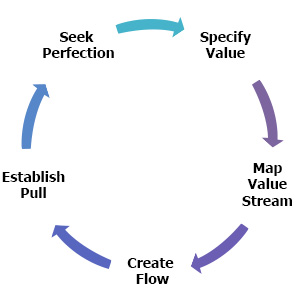Lean Implementation
Lean is a practice that considers the expenditure of resources for any goal other than the creation of value for the end customer to be wasteful & thus a target elimination. Working from the perspective of the customer who consumes products or services,” Value “is defined as any action or process that a customer is willing to pay for.
Implementing lean is a never ending process; this is what continuous improvement is all about. When you get one aspect of lean implemented, it can always be improved. Don't get hung up on it, but don't let things slip back to the starting point. There will always be time to go back and refine some of the processes.
Another thing to keep in mind is this, do not expect everyone in your company to eagerly jump on board and embrace the idea with open arms. Change is difficult even at the best of times. Ensure all members of the company are kept abreast of the progress. A well thought out approach will be your best ally during the implementation phase.
Three Pillars of Lean
- Purpose:What customer problems will the enterprise solve to achieve its own purpose of prospering?
- Process: How will the organization assess each major value stream to make sure each step is valuable, capable, available, adequate, flexible, and that all the steps are linked by flow, pull, and leveling?
- People: How can the organization insure that every important process has someone responsible for continually evaluating that value stream in terms of business purpose and lean process? How can everyone touching the value stream be actively engaged in operating it correctly and continually improving it?
For any product or service, customer typically values for: Quality, Price, Delivery, and Service etc.
- Who defines the Value?
- Value is always defined by customer.
Value in consumption and provision
Consumption is also a process: A series of actions consumers must perform to obtain the value they seek.
Provision is also a process: The actions that providers must perform between the manufacturer and the customer to achieve the objectives of all three parties.
Today there is a gap between producers & customers that makes brilliant objects less satisfying in practice than in theory. We need to enter the age of lean thinking, seamlessly integrating provision and consumption.
The Value Stream

5 Stage lean Implementation Process
- 1. Specify value from the standpoint of the end customer by product family.
- 2. Identify all the steps in the value stream for each product family, eliminating whenever possible those steps that do not create value.
- 3. Make the value-creating steps occur in tight sequence so the product will flow smoothly toward the customer.
- 4. As flow is introduced, let customers pull value from the next upstream activity.
- 4. As value is specified, value streams are identified, wasted steps are removed, and flow and pull are introduced, begin the process again and continue it until a state of perfection is reached in which perfect value is created with no waste

Benefits of Lean Implementation
- Increasing productivity by 30%.
- Reducing defects by 20%.
- Reducing lead times by 70%.
